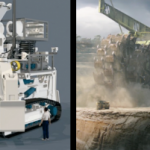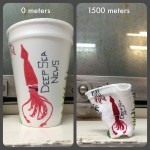Edit – In the original article I said that the sphere of the Deep Challenger was made of titanium. In fact, it’s made of steel. My bad!
In trying to explain to friends, colleagues and Twitter followers during recent days what James Cameron may have seen out that softball-sized window of the Deep Challenger submersible last Sunday, I’ve struggled to convey effectively just how hostile the deep sea environment can really be. It just looks so plain, serene and (in Cameron’s words) desolate. I have one skeptical friend who objected to my statement that, relative to the Marianas Trench “space is easy”. Of course space is not entirely easy. Getting there is the hardest part, and once you’re there, cosmic rays, weightlessness and those nasty bitey little micrometeoroids can play havoc with even the most well-prepared astronaut and his/her spacecraft.
 But there is one property where my throwaway holds true and that is pressure. You see, inside a space capsule the pressure is 1 atmosphere, the same as on land at mean sea level on earth, while the pressure outside the capsule is close to zero: the vacuum of space. That’s a pressure difference of 1 atmosphere. When Deep Challenger descended to the earth’s deepest point, however, it passed that difference at just 10 meters (30ft) below the surface! Indeed, you can experience and survive this difference quite easily for short periods, so that scene in Total Recall where Arnie and Rachel Ticotin’s eyes are bugging out of their heads on the Martian surface? Yeah, not so much. At the bottom of the Marianas Trench, however, the weight of seven miles of water overhead means that the ambient pressure is about 1,100 atmospheres. That’s a different of 1,099 ATM between Mr. Cameron and the outside of that 40-inch sphere he’s jammed into.
But there is one property where my throwaway holds true and that is pressure. You see, inside a space capsule the pressure is 1 atmosphere, the same as on land at mean sea level on earth, while the pressure outside the capsule is close to zero: the vacuum of space. That’s a pressure difference of 1 atmosphere. When Deep Challenger descended to the earth’s deepest point, however, it passed that difference at just 10 meters (30ft) below the surface! Indeed, you can experience and survive this difference quite easily for short periods, so that scene in Total Recall where Arnie and Rachel Ticotin’s eyes are bugging out of their heads on the Martian surface? Yeah, not so much. At the bottom of the Marianas Trench, however, the weight of seven miles of water overhead means that the ambient pressure is about 1,100 atmospheres. That’s a different of 1,099 ATM between Mr. Cameron and the outside of that 40-inch sphere he’s jammed into.
What does that mean though? 1,100 ATM is just an abstract number. OK. Well, in Cameron’s own words, it’s so great that the steel sphere in which he travels to the bottom actually shrinks measurably during descent. One analogy the Deep Sea Challenge team uses (and I quoted yesterday) is that 1,100 ATM is equivalent to inverting the Eiffel Tower and resting its point on your big toe. Ouch. Now imagine another Eiffel Tower for every square inch of your body. A second way to think about it is that 1,100 ATM is about the same as the peak pressure that occurs in the chamber of a handgun for a fraction of a second after the bullet fires. Unlike the gun, however, the pressure in Challenger Deep is sustained and pervasive. It’s like living in a moment frozen in time, inside an explosion. If the sub had rivets to pop (which it doesn’t), they would literally become bullets inside the sphere. 1,100 ATM is also a little less than the pressure in a commercial water cutter that uses a high pressure jet of liquid to cut patterns out of steel. It would certainly be enough that after that imaginary rivet popped, the ensuing water jet would slice soft human tissue like butter. Of course, not for very long, because the weakness in the vessel would likely result in catastrophic implosion and instantaneous death for the unfortunate occupant. Outside an appropriately strong metal sphere, the human body would be compressed to a fraction of its volume at the surface as every last void space collapses and the tissues themselves condense under the massive load. I don’t know what the final effect would be, but I’m imagining something like an extra large meat-lovers pizza…

OK, I think we’ve established that the pressure down there is really high and that generally speaking it’s not especially good for one’s health. It couldn’t get worse could it? Well… There are other differences at massive pressures that any organism that wants to live down there has to cope with. Here’s just three:
One important difference concerns cell membranes, those phospholipid bilayers that surround every cell in the body. Cell membranes are “semi-permeable”, which means that some things pass through them and some things don’t. It turns out that the permeability of membranes is very sensitive to pressure, so something as fundamental as keeping water or important molecules inside (or outside) cells becomes harder to manage at hadal pressures. The cells of organisms may shrink like raisins or swell and burst, or simply leak important chemicals in or out, none of which is A Good Thing.
The second difference concerns proteins and enzymes. Proteins are long, complex chains of amino acid molecules that have to fold up like molecular origami in order to work correctly. You can maybe guess that the folding is different under pressure. This is especially important for the class of proteins called enzymes, which are catalysts for chemical reactions in the body (they make the reactions occur but do not themselves change in the process). If enzymes fold incorrectly, then the chemical substrates they work with may no longer fit the enzyme properly and the reaction may cease, or possibly they fit too well and the reaction accelerates out of control. The majority of biochemical reactions in cells are enzyme-mediated, from energy metabolism to cell division, so the effects of enzyme disruption would be profound. Pressure can even make molecules more (or less) toxic. Urea is a good example: it becomes far more toxic as pressure increases. So deep sea sharks, which like all sharks have a lot of urea in their blood, also have a lot more of the protective chemical TMAO to offset this effect than do their shallow water cousins.
The third difference relates to solubility and this is the biggie for fish in the hadal depths. This is because at those sorts of pressures, some organic molecules or organic/inorganic complexes, like bones, can quite literally dissolve and go back into solution in the water and this is hypothesized to prevent fish and other animals with hardened body parts from living at those depths (but we shall see if this holds true!). This process is called, rather confusingly, “remineralization” and it affects the rest of the food web too. The marine snow of animal feces and dead bodies and mucus and other dross that gently falls from the sea surface to the depths, for example, can partly or completely dissolve as it falls, leading to a sort of horizon depth above which it is snowing and below which it is not. In this way remineralization could result in less food making it to the bottom, perhaps contributing to the general sparseness of life.
The old chestnut that “nature abhors a vacuum” might be amended in the deep sea as “nature abhors a vacuum but it is flat-out terrified of 1,100 atmospheres”. It’s difficult to wrap your head around how staggeringly, mind-bogglingly, literally bone-crushingly intense the pressure is down there, and yet there is still life in those dark, cold, silent, heavy depths. You can’t help but wonder how they cope and what things we might learn from the biology of pressure-loving life of the hadal zone: the piezophiles.
Share the post "Cool as a sea cucumber: life (and death) at extraordinary deep sea pressures"






Great article. Deep sea pressure is mind boggling to wrap one’s head around. The bullet example is great- I had never considered that, and it’s such a good visual!
One small detail: The pressure hull is not titanium, but forged from high-strength steel.
thanks again, and keep up the great work.
Thanks Seton, my mistake!
Great comparisons to space travel. I just read Mary Roach’s book about travel in outer space (Packing for Mars), and it’s amazing how innovative people had to get to deal with the effects zero gravity and lack of pressure on everyday bodily functions. Imagine how much we could learn by thinking about how organisms deal with the radically different environment of the deep sea! It’s no wonder so many people compare it to outer space.